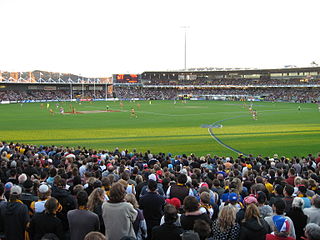Related Research Articles

Launceston is a city in the north of Tasmania, Australia, at the confluence of the North Esk and South Esk rivers where they become the Tamar River (kanamaluka). As of 2021, the Launceston urban area has a population of 90,953. Launceston is the second most populous city in Tasmania after the state capital, Hobart. As of 2020, Launceston is the 18th largest city in Australia. Launceston is the fifth-largest inland city and the ninth-largest non-capital city in Australia. Launceston is regarded as the most livable regional city, and was one of the most popular regional cities to move to in Australia from 2020 to 2021. Launceston was named Australian Town of the Year in 2022.

Zeehan is a town on the west coast of Tasmania, Australia 139 kilometres (86 mi) south-west of Burnie. It is part of the West Coast Council, along with the seaport Strahan and neighbouring mining towns of Rosebery and Queenstown.

York Park is a sports ground in the Inveresk and York Park Precinct, Launceston, Australia. Holding 19,500 people, York Park is known commercially as University of Tasmania (UTAS) Stadium and was formerly known as Aurora Stadium under a previous naming rights agreement signed with Aurora Energy in 2004. Primarily used for Australian rules football, its record attendance of 20,971 was set in June 2006, when Hawthorn Football Club played Richmond Football Club in an Australian Football League (AFL) match.

Sir Adye Douglas was an Australian lawyer and politician, and first class cricket player, who played one match for Tasmania. He was Premier of Tasmania from 15 August 1884 to 8 March 1886.
Mount Read is a mountain located in the West Coast region of Tasmania, Australia, and is at the north west edge of the West Coast Range.

The Queen River, part of the King River catchment, is a minor perennial river located in the West Coast region of Tasmania, Australia. It is notable for its high level of pollution caused by mining runoff which has led the river to be uninhabitable to life.
The Mount Jukes mine sites were a series of short-lived, small mine workings high on the upper regions of Mount Jukes in the West Coast Range on the West Coast of Tasmania.
The mines of the West Coast of Tasmania have a rich historical heritage as well as an important mineralogical value in containing or having had found, specimens of rare and unusual minerals. Also, the various mining fields have important roles in the understanding of the mineralization of the Mount Read Volcanics, and the occurrence of economic minerals.
The history of the Railways on the West Coast of Tasmania has fascinated enthusiasts from around the world, because of the combination of the harsh terrain in which the railways were created, and the unique nature of most of the lines.
The Strahan–Zeehan Railway, also known as the "Government Railway", was a railway from Strahan to Zeehan on the west coast of Tasmania.

Australian rules football in Tasmania, has been played since the late 1870s and draws the largest audience for a football code in the state.
William Harper Twelvetrees was an English geologist who was important for the characterisation of the geology of Tasmania.

Mount Bischoff is a mountain and former tin mine in the north-western region of Tasmania, Australia. The mountain is situated adjacent to Savage River National Park near the town of Waratah.

Dundas was a historical mining locality, mineral field and railway location on the western foothills of the West Coast Range in Western Tasmania. It is now part of the locality of Zeehan.
James Crotty was an Irish-born Australian mining prospector who formed a mining company, the North Mount Lyell mining company, in the western region of Tasmania, just before the turn of the twentieth century.

David Sydney "Syd" Jackson was an Australian politician. He was a Nationalist Party member of the Australian House of Representatives from 1919 to 1929, representing the electorate of Bass.

Zeehan railway station in Tasmania, was a major junction and railway yard for numerous different railway and tramway systems in western Tasmania in the town of Zeehan.

Heinrich Wilhelm Ferdinand "Ferd" Kayser, was the mine manager of Mount Bischoff Tin Mining Company for thirty years.
The Tamar Hematite Iron Company (THIC) was an iron mining and smelting company that operated from April 1874 to December 1877, in the area close to the location of the modern-day township of Beaconsfield, Tasmania, Australia.

Chin Kaw, also known as Ah Kaw or Ah Caw, was a prominent Chinese Australian storekeeper, philanthropist, and mining entrepreneur in Launceston, Tasmania, Australia, who recruited workers from China for the Tasmanian tin-mining industry and thereby helped Chinese immigrants settle in Australia.
References
- Whitaker, Richard (2005). Australia's Natural Disasters. Reed New Holland. ISBN 1-877069-38-8.